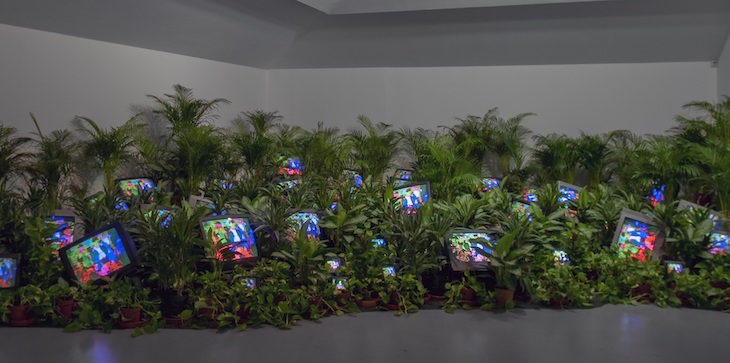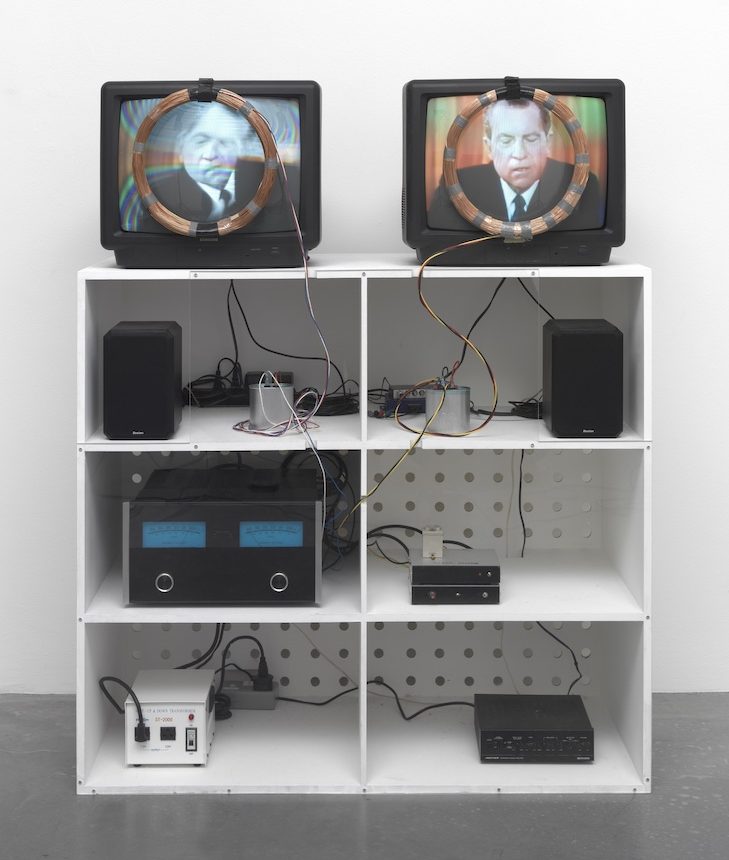Visitors to Tate Modern’s sweeping retrospective of Nam June Paik are greeted with the following words from the Korean-born artist and technological innovator: ‘My experimental TV is not always interesting but not always uninteresting. Like nature, which is beautiful, not because it changes beautifully, but simply because it changes.’ These lines, taken from the brochure that accompanied Paik’s 1963 exhibition Exposition of Music – Electronic Television, seem an appropriate place to begin this examination of an artist who viewed the rise of television as neither trivial nor terrifying, but as an intrinsic element of the modern landscape. Paik’s efforts to integrate natural and electronic worlds is one of several themes woven through an exhibition that documents the artist’s experiments in art and technology from the 1950s to the 1990s. It’s a theme that is materialised quite literally – and with Paik’s characteristically playful touch – in one of the exhibition’s most memorable images, the installation TV Garden (1974–77), which features an array of variously sized television sets nestled within a bed of living plants like a new season’s crop beginning to emerge.
TV Garden (1974–77), Nam June Paik, installation view at the Kunstsammlung Nordrhein-Westfalen, Dusseldorf in 2002

Paik is undoubtedly the quintessential artist of the television and the cathode ray tube, but curators Sook-Kyung Lee and Rudolf Frieling remind us that he originally trained as a musician – he was tutored in piano in Korea and later studied composition and music history in Japan and Germany. Paik’s own forays into music composition and instrument creation are highlighted here, as is his relationship to key figures of post-war avant-garde music, from John Cage to Karlheinz Stockhausen. Cage more than anyone appears to have inspired Paik to embrace the unpredictability of performance art. Hommage à John Cage: Music for Audiotapes and Piano from 1959 was Paik’s first work outside the boundaries of conventional music; the following year Paik would perform Etude for Pianoforte with Cage himself in attendance. The performance, something between a tribute and a ritualistic sacrifice, involved Paik playing Chopin, before attacking the piano, pouring shampoo over Cage’s head and cutting his tie in half with a pair of scissors.
A large room at Tate is devoted to Exposition of Music – Electronic Television, which took place at Galerie Parnass in Wuppertal, Germany in 1963 and marked a transition between the artist’s early music experiments and the television works for which he would later become known. Paik filled three floors of the villa-turned-gallery with interactive sculptures, transfigured and invented instruments, and modified televisions (not to mention the head of a slaughtered ox). By displaying a selection of these works alongside maps, publicity posters and photographs, the Tate exhibition manages to evoke some of the creative chaos of the original event. Included here is Zen for TV (1963), made up of a TV set standing on its side displaying a single white line on its screen, an early indication that despite the likely cacophony of Paik’s ‘happening’, he nevertheless viewed television as a medium with spiritual and meditative potential.
Nixon (1965/2002), Nam June Paik. Courtesy Tate

The Tate exhibition exposes the diversity of Paik’s output, from radio-controlled robots to collage work, to some surprisingly tender sketches and drawings (a particularly lovely watercolour simply displays the words ‘It rains in my TV as it rains in my heart’). Yet it is still the television works that best incapsulate and communicate Paik’s infectious creative energy. The artist is at his best when pushing the popular medium to the threshold of its aesthetic capabilities and then beyond. In works such as Nixon (1965), Paik directly manipulates the material properties of the television signal and cathode ray tube, in this case using magnetic coils to bend and distort the image of a soon-to-be disgraced American president. A particularly impressive collection of Paik’s video art made for television broadcast is displayed here, including his ambitious satellite projects of the 1980s such as Good Morning, Mr. Orwell and Bye Bye Kipling. The latter linked New York, Seoul and Tokyo during the Asian Games and presented Lou Reed, Kabuki theatre, Philip Glass, Kodo drummers and Keith Haring in a kaleidoscopic display of art and music that feels like Paik was attempting to jam the entire transnational culture of the decade into the confined space of the television set. These works feature the psychedelic image manipulations produced by the Paik-Abe Video Synthesizer, a video mixing board Paik created in 1969–71 in collaboration with electrical engineer Shuya Abe that allowed him to edit and reconfigure multiple video sources in real time.
The final room of the exhibition seems intended to be the most spectacular, the first recreation of the Sistine Chapel video work that was a central element of Paik’s contribution to the German pavilion at the 1993 Venice Biennale. The installation involves a range of projectors (the original used 42) throwing overlapping images across the walls of the gallery, creating an enveloping experience much more akin to the immersive media environments now common in contemporary art. But the artist’s video images are somehow reduced rather than enhanced by being let loose from their state of confinement and ultimately Paik is at his most exciting when exploring the bounded, yet infinite space of the television screen.
‘Nam June Paik’ is at Tate Modern until 9 February 2020.



